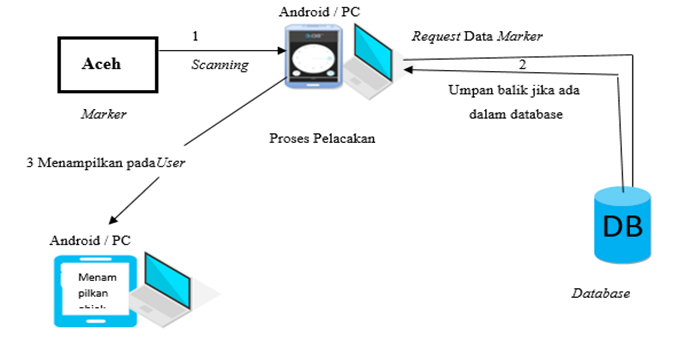Main Article Content
Abstract
Aceh Province, especially Langsa City, has a tourist attraction, namely the Langsa City Forest Park House (RTH). One of the most interesting rides in Langsa City Forest Park is Rumoh Aceh. Based on the results of visits and interviews by Rumoh Aceh officers, the large number of visitors from outside Aceh with one officer sometimes made it difficult for the officers to explain the information available about Rumoh Aceh, especially Acehnese traditional clothes, which were only displayed from a printed image, and provided no other information about these traditional clothes, so that many visitors did not know the diversity of designs and motifs of traditional clothes in Aceh. So, a medium was formed that could display Acehnese traditional clothing. The media uses augmented reality technology so that users can add virtual objects to the real environment to make it easier to use. This application uses the Speed Up Robust Featured (SURF) algorithm, which can process marker tracking quickly so that it can obtain better tracking speed times. The shortest distance from the marker to the camera that can show 3D objects is 20 cm, whereas the farthest distance that cannot show 3D objects is 100 cm. The best distance at which a marker can be detected is 20–80 cm. The best average detection time is 0.00049 s, and the average speed obtained is 1261.22 m/s at a distance of 60 cm. The Speed Up Robust Featured (SURF) algorithm can be used in the Augmented Reality-based Aceh Traditional Clothing Recognition application.
Keywords
Article Details

This work is licensed under a Creative Commons Attribution-NonCommercial 4.0 International License.
References
- A. Ihsan, N. Fadillah, and C. R. Gunawan, “Acehnese traditional clothing recognition based on augmented reality using hybrid tracking method,” Indones. J. Electr. Eng. Comput. Sci., vol. 20, no. 2, pp. 1030–1036, 2020, doi: 10.11591/ijeecs.v20.i2.pp1030-1036.
- C. R. Gunawan, N. Nurdin, and F. Fajriana, “Acehnese Traditional Clothing Recognition Prototype System Design Based On Augmented Reality,” Int. J. Eng. Sci. Inf. Technol., vol. 2, no. 3, pp. 100–105, 2022, doi: 10.52088/ijesty.v2i3.314.
- R. Miwanda, I. A. Kadir, and T. Makmur, “Implementasi Penataan Ruang Terbuka Hijau ( RTH ) Taman Hutan Kota Oleh Pt . Pekola Di Kota Langsa,” vol. 6, no. November, 2021.
- M. M. Mukti Qamal, Fajriana, “Metode Naïve Bayes Untuk Menentukan Rekomendasi Tempat Wisata Terbaik Di Aceh,” Techsi, vol. 13, pp. 81–91, 2021.
- Nurdin et al., “Detection System of Aceh Ethnic Music Types Based on Sound Using the Hubbard Stratonovich Transformation Method,” J. Phys. Conf. Ser., vol. 1363, no. 1, 2019, doi: 10.1088/1742-6596/1363/1/012076.
- A. Nugroho and B. A. Pramono, “Aplikasi Mobile Augmented Reality Berbasis Vuforia Dan Unity Pada Pengenalan Objek 3D Dengan Studi Kasus Gedung M Universitas Semarang,” J. Transform., vol. 14, no. 2, p. 86, 2017, doi: 10.26623/transformatika.v14i2.442.
- N. Rismayani and N. S. Layuk, “Implementation of Augmented Reality Technology for the Mobile-Based Introduction of Toraja Traditional Clothes,” J. Pekommas, vol. 4, no. 2, p. 155, 2019, doi: 10.30818/jpkm.2019.2040206.
- W. Y. Sulistyo, I. Riadi, and A. Yudhana, “Penerapan Teknik SURF pada Forensik Citra untuk Analisa Rekayasa Foto Digital,” JUITA J. Inform., vol. 8, no. 2, p. 179, 2020, doi: 10.30595/juita.v8i2.6602.
- J. Nurlillah, D. Hamdani, and Y. Nurhayati, “Implementation Of Augmented Reality In The Introduction Of Cakes Using SURF Algorithm In Cilla Snack,” vol. 34, no. 2, pp. 29–40, 2018.
- G. Sulaksono, “Development of android based augmented reality video for tennis courts learning,” J. Sport Area, vol. 6, no. 2, pp. 218–230, 2021, doi: 10.25299/sportarea.2021.vol6(2).6361.
- K. R. P. Reynaldo Yoda Wijaya, “Pembuatan Game Tower Defense Menggunakan Augmented Reality Dengan Unity Engine dan Vuforia pada Android,” J. Infra Petra, 2018.
- D. Sekartaji, D. R. Kuning, and P. A. Bangun, “JITE ( Journal of Informatics and Telecommunication Engineering ) Augmented Reality for Topeng Malangan Face Recognition as a Media,” vol. 5, no. January, pp. 423–432, 2022.
- A. F. Ramadhan, A. D. Putra, and A. Surahman, “Aplikasi Pengenalan Perangkat Keras Komputer Berbasis Android Menggunakanaugmented Reality (Ar),” J. Teknol. dan Sist. Inf., vol. 2, no. 2, pp. 24–31, 2021.
- I. Mustaqim, S. T. Pd, and N. Kurniawan, “Pengenalan Rumah Adat Indonesia Berbasis Augmented Reality dengan Memanfaatkan KTP sebagai Marker,” 2018 Fourth Int. Conf. Comput. Commun. Control Autom., vol. 31, no. June, pp. 36–48, 2016, [Online]. Available: https://www.medigraphic.com/pdfs/educacion/cem-2017/cem172y.pdf
- R. Mauludin, A. S. Sukamto, and H. Muhardi, “Penerapan Augmented Reality Sebagai Media Pembelajaran Sistem Pencernaan pada Manusia dalam Mata Pelajaran Biologi,” J. Edukasi dan Penelit. Inform., vol. 3, no. 2, p. 117, 2017, doi: 10.26418/jp.v3i2.22676.

